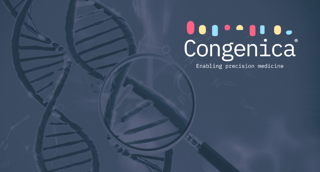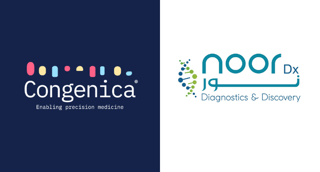Introduction
The evolving molecular testing landscape is leading to an increasing demand not only for testing, but especially for complex interpretation and reporting services. This problem is compounded by the rapid growth in number of patients sequenced, enabled by the significant reduction in NGS sequencing costs over the last two decades, and the lagging growth in global genomics professionals. To better understand the genomic analysis market, Congenica conducted a survey of clinical NGS experts in the US, UK, EU, and China from December 2020 to February 2021.
.png?width=1200&name=Add%20a%20little%20bit%20of%20body%20text%20(2).png)
The results showed that while most laboratories (62%) use a commercial secondary alignment and variant caller (for example, DRAGEN, Sentieon), a larger number of laboratories (65%) are not yet using professional NGS data analysis software – specifically for tertiary annotation, analysis, interpretation, and reporting. Only 21% of respondents use professional tools for both secondary and tertiary analysis. While variant calling is standardized, variant annotation and analysis is often still done via ad-hoc custom pipelines, manual database search, or via spreadsheets. The Congenica survey results are consistent with an Association for Molecular Pathology (AMP) survey [1] that further illustrates the severity and impact of specific challenges in clinical genomics practice, especially genomic analysis & reporting.
The barriers and needs identified by the participants of both surveys are addressable by professional clinical decision support (CDS) tools such as Congenica.
Clinical NGS expert survey
In the survey, Congenica collected feedback from 89 NGS professionals from clinical, academic, and commercial organizations with a broad geographic distribution: 40 participants from the US, 30 from outside the US (concentrated in Europe and the Middle East) and 19 from Asia with a large portion from China.
Participants were classified by organization type, country, region, role, seniority level, and number of samples processed/scheduled. All participants from clinical, academic, and commercial laboratories perform or plan to perform panel, WES, and/or WGS testing for inherited diseases.
Labs share common pain points
Complex analysis was ranked as the most challenging of all genetic testing steps. 65% of the AMP survey participants considered it a significant or high burden. Analysis steps take up ~70% of the total time spent per test at ~6 hours for WGS and ~4.5 for WES. [1] WGS and WES techniques were noted as the most time-consuming, along with panels of >50 genes, averaging 7–9 or 6 hours of effort, respectively, related to data analysis, interpretation, and reporting. These results are consistent with a 2019 UK microcosting analysis study [2] which found that WGS analysis times averaged 11-16 hours for labs that lacked professional bioinformatics tools.
Many directors say their labs are losing money on reimbursement relative to the cost of all tests more complex than single-gene inheritance tests, and strongly agree that data analysis and reporting efforts are NOT adequately reimbursed relative to the effort and time required.
.png?width=1200&name=Add%20a%20little%20bit%20of%20body%20text%20(3).png)
Only one-third of laboratories have adopted professional NGS data analysis software to date
Reasons for the low percentage of adoption of professional NGS data analysis solutions include inertia, lack of awareness, need for flexibility and reimbursement and funding issues. 46% of laboratories cite a lack of in-house expertise as a top 3 barrier to expanding genetic testing. 55% cite reimbursement/coverage. And in the AMP survey, ~80% of labs say they would hire more genetics personnel and run more tests if reimbursement was sufficient for the time spent.
Specialists are clearly busy analyzing tests and do not have a lot of time to invest in looking for ways to improve efficiency. However, the increased availability of genomic tools and professional solutions that can reduce the time spent per case and expertise required, thereby making reimbursement payments stretch further, justify making the time to take a closer look.
Why you should consider replacing your in-house solution with a professional genomic analysis provider
Professional NGS data analysis software and their service organizations can provide secondary and tertiary analysis for clinical NGS by building and maintaining reliable pipelines that enable rapid, reproducible and verifiable analysis. By automating the repetitive steps in the clinical workflow, your staff frees up time to focus on more rewarding tasks.
Reference data in one place
Most clinical geneticists today use only a subset of all available variant databases, likely due to the burden of reviewing many separate online tools, integrating databases, and the search cost from multiple manual queries. According to our survey, the only databases that are consistently used in most laboratories are ClinVar and OMIM. Other datasets, many of which are recommended by best practices and necessary for comprehensive variant interpretation, are not used consistently across laboratories – hypothetically due to lack of availability in a single location. These findings are also reflected in the AMP survey results, which highlight that "Additional Research Required" is the second highest contributor to analysis burden. [1]
It is understandable that many labs are limited in their ability to perform complex analyses due to the time-consuming nature of manual search and the burden of bioinformatics expertise to maintain in-house solutions. 25% of respondents to the market survey say they search databases manually rather than in a single platform that can search all databases simultaneously. This takes several minutes per variant, often with dozens or hundreds of variants per case. Given the rate of discovery and publication and the importance of not overlooking any known variants, genes, or current evidence, it makes sense to pool as many reference data sources as possible to make variant interpretation as robust and comprehensive as possible. All reference data should be regularly and automatically updated and maintained. Preferably, core resources such as ClinVar are supplemented by Mastermind, gnomAD, DECIPHER, and other indication-specific rare disease databases. Professional clinical support solutions for tertiary analysis can put comprehensive, updated reference data at the fingertips of genomic analysts.
Quality control, audit, security and encryption – all are important!
A professional genomic data analysis provider can support you with bioinformatics expertise. The best professional software solutions adhere to strict audit requirements and have fully exportable audit data to simplify laboratory audits – supporting HIPAA requirements for reproducible and fully auditable analysis. They also offer traceability and reproducibility of results, which is an essential requirement for CAP and CLIA certification.
Automation and variant ranking tools save significant analysis time
When asked about specific feature requests, clinical NGS experts consistently cite automated variant classification (including automated ACMG classification) and automated ranking of variants by pathogenicity and phenotypic contribution at the top of their wish list. Both reduce analysis times while automated ranking of variants, often driven by artificial intelligence, additionally improves diagnostic yield by ensuring that analyst’s time is spent reviewing the variants that matter the most.
Patients also benefit from the use of professional solutions for genomic data analysis
Patients clearly benefit from timely and accurate genetic diagnosis that changes their lives. And there is a virtuous cycle in genomics – the more patients diagnosed, the easier it is to diagnose future patients for similar disorders and the more discoveries and treatments can be identified, including novel biomarkers, new drug targets, and understanding of biology.
As our survey shows, clinical geneticists cite many barriers that make it difficult to increase testing volume or to deliver results economically. In fact, 80% of labs say that they would perform more tests if they could do so economically. Given these findings, it is imperative to rethink current practices, and to take a closer look at professional platforms like Congenica that allow genetic analysts to work more efficiently and deliver more results to more patients, at a lower cost.

References
[1]
Analysis of Effort in Molecular Test Interpretation – Quantitative Survey Data Readout,
March 16th, 2021. An AMP report, created with support from AMGEN Oncology Analysis of Effort in Molecular Test Interpretation – Quantitative Survey Data Readout, March 16th, 2021. An AMP report, created with support from AMGEN Oncology https://www.amp.org/AMP/assets/File/advocacy/AMP_MDx_Interpretation_Quant_Survey_Report.pdf?pass=24
[2]
Schwarze, K., Buchanan, J., Fermont, J.M. et al. The complete costs of genome sequencing: a microcosting study in cancer and rare diseases from a single center in the United Kingdom. Genet Med 22, 85–94 (2020).
https://doi.org/10.1038/s41436-019-0618-7
Further reading: How to select a clinical decision support platform

.png?width=1200&name=Add%20a%20little%20bit%20of%20body%20text%20(4).png)

.png?width=320&height=192&name=Add%20a%20title%20(2).png)
